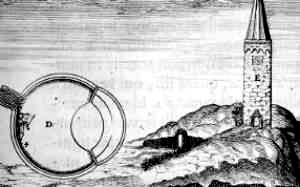Distance Perception
Table of Contents
20. I do not individually explain what gives the soul the opportunity to conceive all the differences in color
We know that:
- overly intense light can harm vision
- moderate light can refresh it, especially the color green
Green consists of the proportion of 1:2 and is related to the octave in musical consonances.
Green is like daily bread, as opposed to other types of food which give more pleasure.
The novelty of the non-green colors are endearing and often provide greater delight to the sight than green.
- They are like excellent and unusual musical modulations or the delicate food of a wise cook.
They initially stimulate the senses like a pleasant itch.
- But they quickly cause weariness and nausea much faster than simple and ordinary objects.
How does the soul perceive the position, shape, distance, size, and other similar qualities?
These are perceived by many of our senses.
For example, when hand A touches object C, the parts of the brain B, from which the filaments of those nerves originate, are arranged differently than if it were touching something else, whether in shape, size, or location.

Therefore, the soul can perceive the position, shape, size, and similar qualities of the object in a peculiar way depending on how it is affected.
Similarly, if the eye D looks at the object E, the soul will be able to perceive the position of that object.
- This is because the nerves of that eye will be arranged differently than if it were looking elsewhere.
It will recognize its shape because:
- the rays from point
1converge at point2to the optic nerve - the rays from point
3converge at point4, and so on for the others
These will paint a shape exactly similar to its own shape.

It will also be able to perceive the distance of point 1 because the arrangement of the crystalline humor will be different for the other figure.
- In this way, all rays coming from this point will precisely converge at point
2on the fundus of the eye. - This fundus is the medium between distant and near.
The soul will be able to perceive the shapes of point 3 and all the others from which rays will enter the eye simultaneously.
- This is because with the crystalline humor arranged in that way, the rays from point
3will not converge as precisely at point4as those coming from point1converge at point2.
But it does not preserve the same proportion as to the forces acting, as at other times.